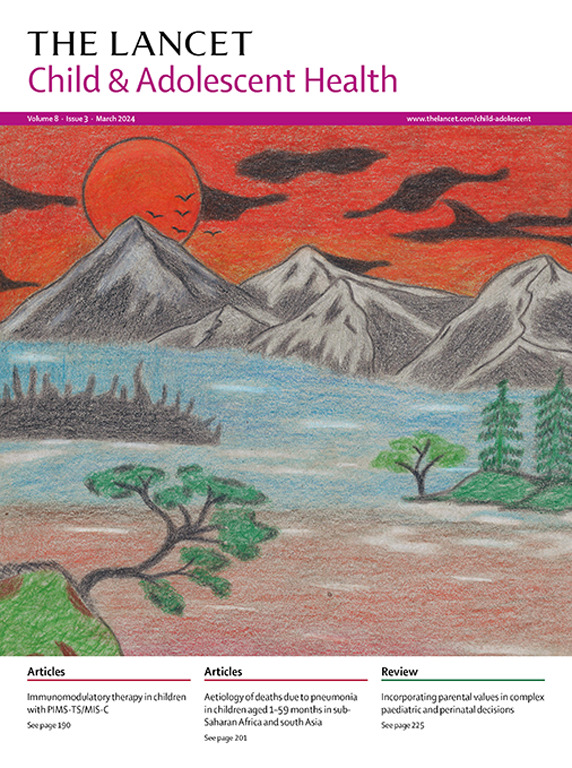青春期痛经与成年期慢性疼痛之间的纵向关联:一项基于英国人群的研究。
IF 15.5
1区 医学
Q1 PEDIATRICS
引用次数: 0
摘要
背景:痛经困扰着许多青少年,由于各种社会文化的原因,痛经往往得不到治疗。痛经经常与其他慢性疼痛同时发生,与对照组相比,痛经的成年女性有更大的感觉敏感性。我们的目的是通过估计15岁时经历痛经的成年期慢性疼痛的风险,来检验青春期痛经导致包括骨盆外疼痛的一般慢性疼痛发展的假设。方法:我们使用来自雅芳父母和儿童纵向研究(ALSPAC)的数据,该研究是一项纵向出生队列研究,研究对象是预产期在1991年4月1日至1992年12月31日之间的英国雅芳的母亲及其子女。每年从8岁到17岁的孩子被问及痛经的问题。在15岁时,参与者还被要求描述他们的痛经经历,分为轻度、中度和重度。在26岁时,参与者在回答以下问题时报告了他们是否感到疼痛:“在过去的一个月里,你是否有过持续一天或更长时间的疼痛?”(是或否);“什么时候开始疼的?”(<3个月前或≥3个月前)。任何慢性疼痛(持续时间≥3个月)是主要结局。为了进行分析,我们排除了初潮前有疼痛状况的参与者和26岁时急性疼痛持续时间少于3个月的参与者。通过多次插值解决了缺失数据。为了估计26岁时青春期痛经(无痛经、轻度痛经、中度痛经或重度痛经)发生慢性疼痛的风险,我们使用了多变量logistic回归模型,调整了先前与痛经和慢性疼痛相关的混杂因素(种族、母亲的教育水平、0-10岁的不良童年经历、月经初潮前的抑郁症状、月经初潮时剧烈运动的频率、月经初潮时吸烟、多不饱和脂肪酸摄入量(根据10岁时完成的食物日记,以及初潮时的BMI),以产生慢性疼痛的相对风险[rr]。剂量反应在调整后的回归模型中进行研究,痛经严重程度为数值变量。在痛经被报道为潜在的介质后2年内,我们使用1000次模拟的bootstrapping检查了焦虑和抑郁症状。研究样本包括1157名参与者,其中691名(59.7%)在15岁时报告有中度或重度痛经。在307名(26.5%)在26岁时报告慢性疼痛的参与者中,32名(17.3%)在15岁时没有痛经,而62名(22.1%)患有轻度痛经,157名(30.0%)患有中度痛经,56名(33.5%)患有重度痛经。与无痛经相比,26岁时轻度慢性疼痛的调整后危险度为1.23 (95% CI 0.85 - 1.74, p= 0.27),中度痛经的调整后危险度为1.65 (95% CI 1.22 - 2.18, p= 0.0021), 15岁时重度痛经的调整后危险度为1.76 (95% CI 1.23 - 2.39, p= 0.0030)。这些结果对应于轻度痛经的绝对调整风险差异为4.8个百分点(95% CI -2·5至12.1),中度痛经的绝对调整风险差异为12.7个百分点(5.9至19.4),重度痛经与无痛经的绝对调整风险差异为16.2个百分点(7.2至25.2)。焦虑和抑郁症状介导严重痛经和慢性疼痛之间的关联的一小部分。焦虑和抑郁症状在重度痛经患者中的中介作用最大。青少年痛经会对健康产生负面影响,并导致成年后慢性疼痛的风险增加,因此为呼吁将青少年痛经视为一个重要的公共卫生问题提供了支持证据。未来的工作应侧重于早期识别和有效管理,包括非药物策略和自我管理,这依赖于继续努力提高年轻人的月经素养。FUNDINGUK研究与创新战略重点基金高级疼痛发现平台,由英国研究与创新(英国医学研究委员会、生物技术与生物科学研究委员会、经济与社会研究委员会)、Versus Arthritis、医学研究基金会和礼来公司共同资助。本文章由计算机程序翻译,如有差异,请以英文原文为准。
Longitudinal association between dysmenorrhoea in adolescence and chronic pain in adulthood: a UK population-based study
Background
Dysmenorrhoea affects many adolescents and often goes untreated for various sociocultural reasons. Dysmenorrhoea frequently co-occurs with other chronic pain conditions, and adult women with dysmenorrhoea have greater sensory sensitivity compared with controls. We aimed to test the hypothesis that adolescent dysmenorrhoea leads to the development of general chronic pain, including pain outside the pelvis, by estimating the risk of chronic pain in adulthood following the experience of dysmenorrhoea at age 15 years.
Methods
We used data from the Avon Longitudinal Study of Parents and Children (ALSPAC) a longitudinal birth cohort of mothers with an expected delivery date between April 1, 1991, and Dec 31, 1992, and their children in Avon, UK. Each year from ages 8 to 17 years, children were asked about dysmenorrhoea. At age 15, participants were also asked to describe their experience of dysmenorrhea as mild, moderate, or severe. At age 26 years, participants reported any pain in response to the questions: “Have you had any aches or pains that have lasted for a day or longer in the past month?” (yes or no); and “When did the pain start?” (<3 months ago or ≥3 months ago). Any chronic pain (≥3 months in duration) was the primary outcome. For the analysis, we excluded participants with a pain condition before menarche and participants with acute pain lasting less than 3 months at age 26 years. Missing data were addressed by multiple imputation. To estimate the risk of chronic pain at age 26 years when experiencing dysmenorrhoea in adolescence (none, mild, moderate, or severe), we used multivariable logistic regression models, adjusted for confounders previously associated with dysmenorrhoea and chronic pain (ethnicity, mother's education level, adverse childhood experiences from ages 0–10 years, depressive symptoms preceding menarche, frequency of vigorous physical activity at menarche, smoking at menarche, polyunsaturated fatty acid intake as per food diaries completed at age 10 years, and BMI at menarche), to generate relative risks [RRs] for chronic pain. Dose response was investigated in an adjusted regression model with dysmenorrhoea severity as a numeric variable. We examined anxiety and depressive symptoms in the 2 years after dysmenorrhoea was reported as potential mediators using bootstrapping with 1000 simulations.
Findings
The study sample included 1157 participants, 691 (59·7%) of whom reported moderate or severe dysmenorrhoea at age 15 years. Of the 307 (26·5%) participants who reported chronic pain at age 26 years, 32 (17·3%) had no dysmenorrhoea at age 15 whereas 62 (22·1%) had mild, 157 (30·0%) had moderate, and 56 (33·5%) had severe dysmenorrhoea. Adjusted RRs for any chronic pain at age 26 years were 1·23 (95% CI 0·85–1·74, p=0·27) for mild, 1·65 (1·22–2·18, p=0·0021) for moderate, and 1·76 (1·23–2·39, p=0·0030) for severe dysmenorrhoea at age 15 years compared with no dysmenorrhoea. These findings correspond to an absolute adjusted risk difference of 4·8 percentage points (95% CI –2·5 to 12·1) for mild dysmenorrhoea, 12·7 percentage points (5·9 to 19·4) for moderate dysmenorrhoea, and 16·2 percentage points (7·2 to 25·2) for severe dysmenorrhoea compared with no dysmenorrhea. Anxiety and depressive symptoms mediated a small proportion of the association between severe dysmenorrhoea and chronic pain. The mediating role of anxiety and depressive symptoms was greatest among participants with severe dysmenorrhoea.
Interpretation
Dysmenorrhoea in adolescence adversely affects immediate wellbeing and contributes to an increased risk of chronic pain in adulthood, thus lending supporting evidence to calls to consider adolescent dysmenorrhoea a crucial public health issue. Future work should focus on early identification and effective management, including non-pharmacological strategies and self-management, which relies on continuing work to improve young people's menstrual literacy.
Funding
UK Research and Innovation Strategic Priorities Fund Advanced Pain Discovery Platform, a co-funded initiative by UK Research and Innovation (UK Medical Research Council, Biotechnology and Biological Sciences Research Council, and Economic and Social Research Council), Versus Arthritis, the Medical Research Foundation, and Eli Lilly and Company.
求助全文
通过发布文献求助,成功后即可免费获取论文全文。
去求助
来源期刊

Lancet Child & Adolescent Health
Psychology-Developmental and Educational Psychology
CiteScore
40.90
自引率
0.80%
发文量
381
期刊介绍:
The Lancet Child & Adolescent Health, an independent journal with a global perspective and strong clinical focus, presents influential original research, authoritative reviews, and insightful opinion pieces to promote the health of children from fetal development through young adulthood.
This journal invite submissions that will directly impact clinical practice or child health across the disciplines of general paediatrics, adolescent medicine, or child development, and across all paediatric subspecialties including (but not limited to) allergy and immunology, cardiology, critical care, endocrinology, fetal and neonatal medicine, gastroenterology, haematology, hepatology and nutrition, infectious diseases, neurology, oncology, psychiatry, respiratory medicine, and surgery.
Content includes articles, reviews, viewpoints, clinical pictures, comments, and correspondence, along with series and commissions aimed at driving positive change in clinical practice and health policy in child and adolescent health.
 求助内容:
求助内容: 应助结果提醒方式:
应助结果提醒方式:


